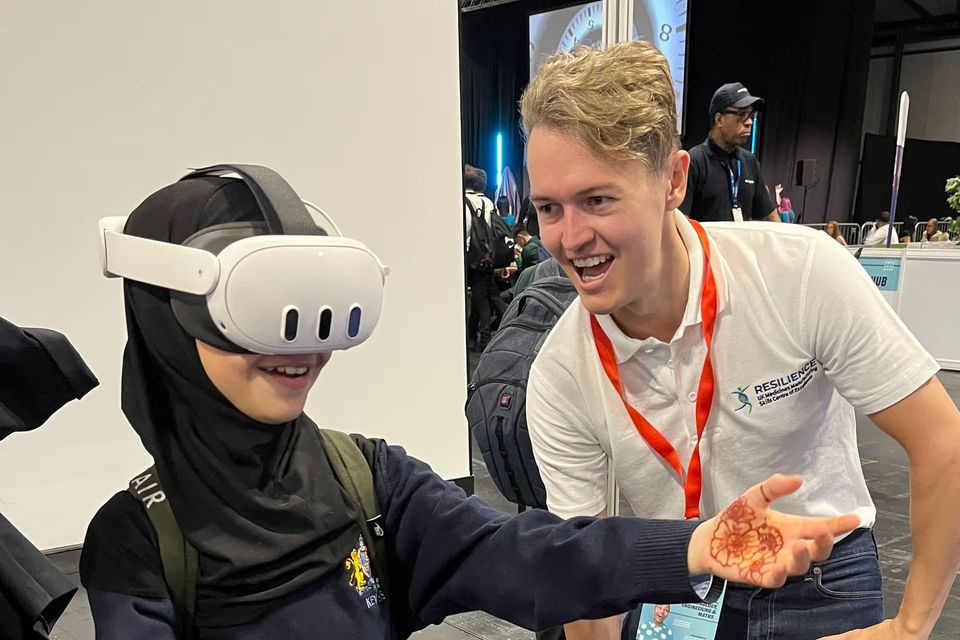Big Bang Fair Reflections
20 June 2025
RESILIENCE attended the Big Bang Fair (17 - 19th June 2025, NEC Birmingham) hot on the heels of the Cheltenham Science Festival because we are dedicated to supporting schools develop their science curricula to incorporate current knowledge about medicines manufacturing. How did it go and how did we do?

Why were we there?
The Big Bang Fair was very relevant to the RESILIENCE ethos as it is focused on introducing science and engineering careers through hands-on activities and shows. It is also a valuable source of inspiration and resources for teachers – they can use the materials they discover at the fair to inspire and shape their own STEM events. The event helps young people aspire to develop careers in engineering, science education and communication, and healthcare. Importantly, it is free and only open to UK state-funded (years 6-8: England and Wales, P7-S2: Scotland, years 7-9: Northern Ireland) school groups.
RESILIENCE’s activities featured virtual reality (VR) simulations (pipetting, microscopy, weighing activities) designed using the FourPlus Immersive software, Eclipse Creator. We also provided pipetting, molecular modelling, and Lego (building laboratory apparatus and tools) activities.
Excited students, impressed teachers
The first day of the fair was greeted by excited crowds of school children and their teachers who likely saw the event as an opportunity for structured play. Things went at a reasonable pace interspersed with busy periods as students enjoyed the range of activities on offer at the RESILIENCE stand. Teachers scouted our featured materials (molecular modelling flashcards, colouring book, laboratory notebook, pipetting activity) while their students methodically worked through each activity (VR was very much in demand) and collected their participation prizes (science stickers and sweets until they run out). A respectable number of teachers registered their schools as free standard RESILIENCE members, driven by access to resources that they could use to extend their teaching, but they were also genuinely impressed with our approach to delivering STEM career training and education.

A careers advisor asked for specific information about careers support provided by RESILIENCE and we directed her to the website where she could find (as a free standard member) our Unifrog career videos, information on skills accelerator courses, and short courses focussed on STEM careers in pharmaceutical manufacturing. A chemistry teacher kept coming back to the stand to look at the molecular modelling flashcards and kit. He talked excitedly about telling the lead for chemistry at his school about the activity and taking this on board for their chemistry lessons. An undergraduate volunteer at the fair approached us during the lunch break to ask if we offered summer lab placements. We were able to tell her that all of the RESILIENCE centres offered work experience and after a brief discussion about logistics, she decided to attend a 2-day lab summer placement at UCL.
Building more than models
The students were, as usual, wonderfully captivated by everything RESILIENCE had to offer and expressed their exuberance in the results of the activities they engaged in. A student and her friend came to the stand, opened a notebook to a page with a list of chemical formulas for water, glucose, vinegar etc., and asked if they could build the structure of one of those. We suggested glucose and they politely declined, saying they’d already built that one. They wanted to model the structure of vinegar (acetic acid). We didn’t have time to explain how to determine the shape of the molecule just by looking at the formula, so we looked this up online. With more time, we would look at functional groups, bonding, and valence shell electron pair repulsion (VSEPR) theory to explain the 3D structure. In the end, we helped the students identify the carboxylic acid functional group on acetic acid once they had built the model. One ambitious student wanted to build doxorubicin (quite a big molecule) but he settled for paracetamol after his friend badgered him to hurry up because he wanted to see other stands! Some of the students who really cared about Lego were up for the challenge of building our most difficult apparatus, the microfluidic chip. One student did his own thing and built a round bottom flask from one of the science stickers we were handing out as prizes.

Final Reflections
The Big Bang fair was overall, a hugely positive experience. The key lesson was that this is a great event for beginning conversations and collaborations with schools. It is also a significant opportunity to meet students who are starting to consider their next steps in further education and preparing for their careers. We will apply those lessons to refining our outreach strategies for Big Bang Fair 2026.

